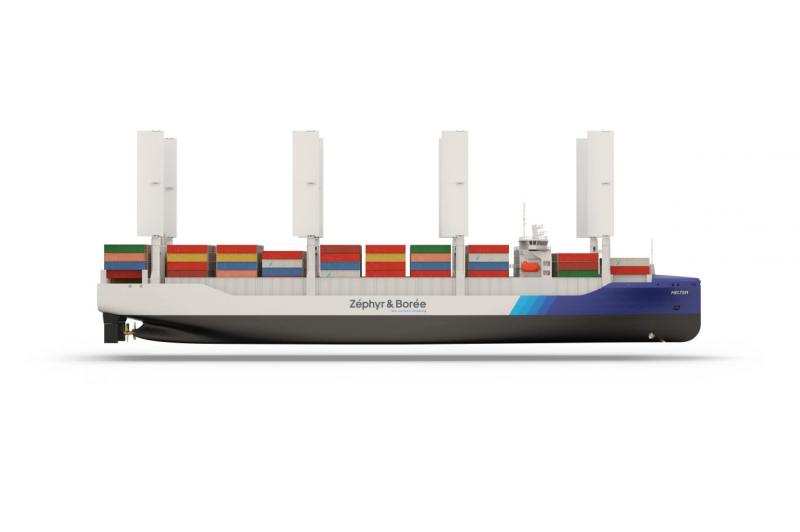28 November 2024
Wind-Assisted Containership gets AiP from BV

French classification society Bureau Veritas (BV) has issued an Approval in Principle (AiP) to Zéphyr & Borée. The first open-top 1,800 TEU wind-assisted containership got AiP. Hence, demonstrating the feasibility of using wind-propelled wing-sails on this type of vessel.
Concept
So, the 185m long container vessel has five cargo holds, mostly open-top. The propulsion system is meeting the IMO’s Tier III requirements. Moreover, the vessel has shaft generators and a heat recovery system to minimize fuel consumption.
Above all, the vessel’s propulsion system includes assistance from eight sails provided by CWS (Computed Wing Sails). The proposed design is a thick, asymmetrical wing-sail that is able to steer to catch port and starboard winds. Additionally, it adjusts itself automatically depending on the wind conditions to ensure optimal savings.
Furthermore, BV involved in the design from the very early stages. Therefore reviewing the main design principles in order to ensure the feasibility of the concept and identify any obstacles. The AiP confirms the design’s compliance with the most recent BV notations, including NR 206 on Wind Propulsion systems.
Comments
“We are convinced that the wind energy will play an important role in the years to come to decarbonise ships’ propulsion. The integration of sails on container ships is an important technical challenge on which we are working hard at Zéphyr & Borée. We are delighted to collaborate with BV on this project, which represents a key milestone by demonstrating the viability of wing-sails as a wind propulsion solution for container ships. We intend to continue our work with maritime stakeholders to offer wind propulsion solutions that are economically viable and make a tangible difference for the sector.”
Nils Joyeux, CEO at Zéphyr & Borée
“Wind, even if it is not always available, is a serious option to help decarbonise the shipping industry. Wind propulsion systems can play a significant role by providing substantial propulsive energy. With this AiP, we are pleased to demonstrate the technology can be applied to containerships, which represent 17.5% of the global fleet (in tonnage). Bureau Veritas continues to lead the way in developing guidelines and frameworks for the safe and efficient use of this promising technology.”
Laurent Leblanc, Senior Vice President Technical & Operations at Bureau Veritas Marine & Offshore
Relevant Framework from BV
To help clients move forward with wind-assisted propulsion, BV has released classification rules that provide a framework for wind propulsion systems (WPS). These rules address safety and reliability from the design review stage through installation and operations. This includes survey regimes and maintenance requirements. To comply with WPS rules, ships must undergo the following:
- Risk analysis
- Determine local and general ship strength
- Define load cases, automation, and release systems.
Nerd Thoughts
The current use of alternative fuels and renewable energy sources within the shipping industry is still relatively scarce. In addition, the environmental legislation for emissions reduction is growing and seems to threaten the performance of ships.
Considering these concerns, there is the need to develop and apply innovative alternative power and propulsion technology for ships.
Therefore, the industry players are increasingly putting a modern spin on one of the oldest concepts in shipping. On another approach, Norsepower installs Rotor Sails on hybrid ferries to provide a 4 – 5% CO2 reduction.
It is exciting to witness the harnessing of wind energy for ship propulsion and its developments. We can see similar developments in BARTech WindWings by Yara Marine getting AiP from DNV.
Hope for more soon…


